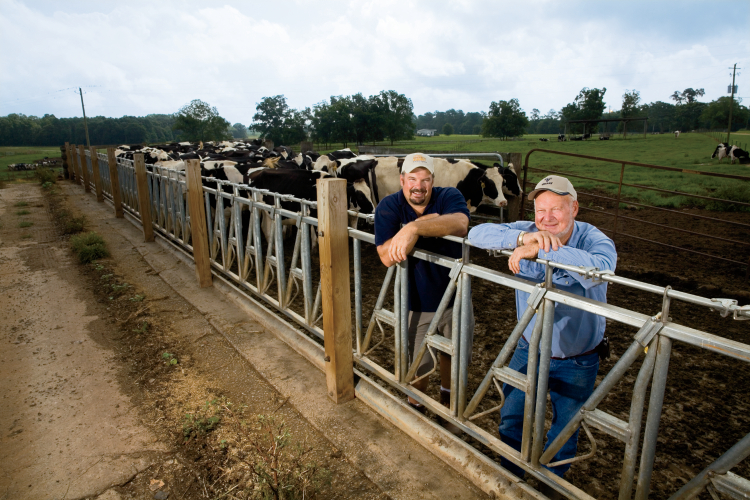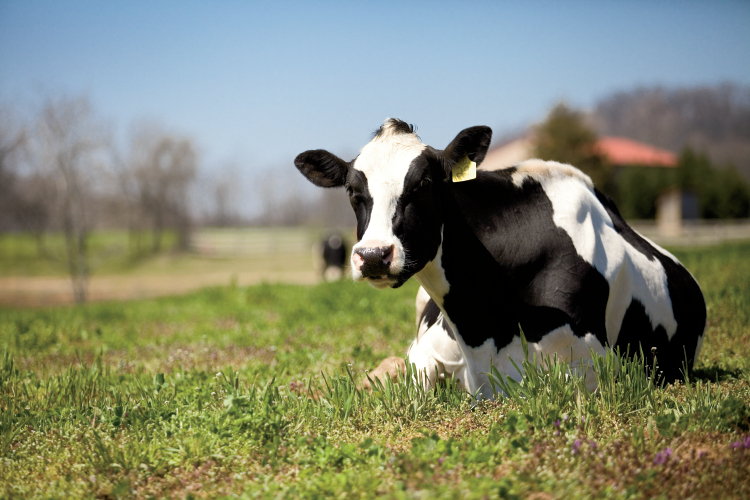Home > Georgia > Georgia Crops & Livestock > Got Georgia Dairy?
Got Georgia Dairy?
For Georgia dairy farmers like Bud Butcher, the desire to supply a safe, quality milk product is more than just his job. It’s personal.
“As food producers, we are the only industry that produces something that people absolutely cannot live without,” Butcher explains. “And Ithink that 98 percent of the people that produce food, whether it’s milk or strawberries, conscientiously try to do a good job of producing a wholesome product that people will like.”
Butcher, a third-generation dairy farmer, has worked at Butcher Family Dairy for more than 30 years. Located in Senoia, the 300-acre farm is also home to Butcher’s own family, including his son and business partner Kirk Butcher. With the aid of four employees, the Butchers maintain and milk approximately 350 Holsteins every day.
Major Georgia Industry
Farrah Newberry, executive director of Georgia Milk Producers, says Georgia is a key player in the American dairy industry. Like the Butcher Family Dairy, many of the state’s farms are family-owned, averaging 375 cows.
In 2012, the Georgia Department of Agriculture reported that 55 percent of the milk produced in Georgia was exported to other states.
“As far as the Southeast, we’re probably the top dairy state in the United States,” Newberry says. “We have the most milk production. Many of our surrounding states have lost production and dairy farms over the last decade, but we’ve been able to maintain and actually grow our milk production.”
One way the Butcher Family Dairy maintains milk production is by calving (birthing) the cattle year-round rather than seasonally. While Butcher admits that continuous calving increases the difficulty of managing his operation, it has benefited the farm by keeping milk production steady throughout the year.
“Our herd average [of milk production] is 22,500 pounds per cow, per year,” Butcher says. “We tend to feed for the most efficient production.”
Summer Challenges
Georgia’s hot and humid summers present a unique challenge to dairy farmers, who have to work hard to keep cattle as cool as possible in 90-degree heat. The Butchers house their cattle in free-stall barns with fans and water sprinklers.
Other dairies, such as Oak Hill Dairy Farm in Leesburg, have transitioned into tunnel-ventilated barns, which can produce 13 miles per hour winds.
“All the fans are at one end and produce a steady flow of air, based on inside barn temperatures,” says Marty Erickson, Oak Hill’s dairy manager. “We want to have that breeze over the cows to promote cooling.”
A Team Effort
Erickson oversees approximately 30 employees and more than 1,800 dairy cattle daily.
“Ideal with people as much as cows,” Erickson says. “Everything everybody does affects the next guy down the line. Each job (on the farm) is just as important in that phase of the cow’s life. If she doesn’t get milked right, she may get mastitis, and that will affect the guy treating cows. If the guy doesn’t clean the barn, it’ll affect five other guys on the farm. [My job is] to organize that, so that at the end of the day, we have a safe, quality product that leaves here.”
Georgia dairy farmers thrive on the need to produce a superior product, but their main motivation lies in the prospect of improvement.
“I like the challenge of always striving to do better, [whether it’s] growing a better crop or getting more milk,” Butcher says. “There’s no ceiling. No matter how good you do, you could always do better.”





